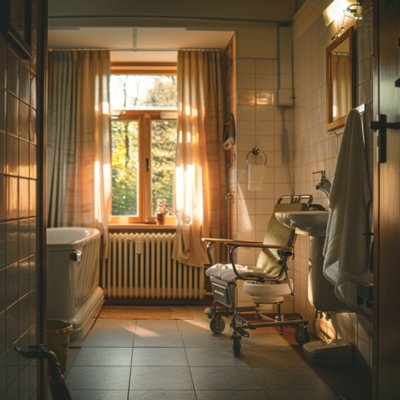When it comes to providing quality care for patients at home or in medical facilities, choosing the right hospital bed is crucial. However, navigating the world of hospital beds can be overwhelming, especially when considering the various types available and their associated costs. At American Homecare Direct, we understand the importance of finding the perfect balance between functionality, comfort, and affordability. In this comprehensive guide, we'll explore the different types of hospital beds, their features, and the factors that influence their costs, helping you make an informed decision for your or your loved one's care needs.
Understanding Hospital Bed Types
Hospital beds come in various types, each designed to meet specific patient needs and care requirements. Let's break down the main categories:
Functionality-Based Categories
- Manual Hospital Beds: These beds are adjusted using hand cranks, offering a cost-effective solution for basic care needs.
- Semi-Electric Hospital Beds: Featuring an electric motor for head and foot adjustments, while height adjustment remains manual, these beds offer a balance between convenience and affordability.
- Fully-Electric Hospital Beds: With all adjustments controlled electronically, these beds provide maximum convenience but come at a higher price point.
Patient Need-Based Categories
- Standard Hospital Beds: Designed for general medical use, these beds are versatile and suitable for most patients.
- Bariatric Hospital Beds: Built with a higher weight capacity, these beds cater to larger patients, ensuring comfort and safety.
- Low Hospital Beds: Ideal for patients at risk of falling, these beds can be lowered close to the ground for added safety.
- Pediatric Hospital Beds: Specially designed with smaller dimensions and child-friendly features for young patients.
- ICU Beds: Equipped with advanced features for critically ill patients, these beds support intensive care needs.
- Birthing Beds: Tailored for labor and delivery, these beds offer specific features to support the birthing process.
- Orthopedic Traction Beds: Designed for patients with bone, joint, or muscle disorders, these beds provide specialized support and positioning options.
Breaking Down Hospital Bed Costs
The cost of a hospital bed can vary significantly based on its type, features, and brand. Let's explore the price ranges for different categories:
Functionality-Based Categories
-
Manual Hospital Beds
- Price Range: $500 - $1,000
- Most economical option
- Suitable for patients who don't require frequent position changes
-
Semi-Electric Hospital Beds
- Price Range: $800 - $2,000
- Offers a balance between convenience and cost
- Ideal for patients who need regular head and foot adjustments
-
Fully-Electric Hospital Beds
- Price Range: $1,200 - $4,000
- Most convenient option with all electronic adjustments
- Best for patients requiring frequent repositioning or those with limited mobility
Patient Need-Based Categories
-
Standard Hospital Beds
- Price varies based on functionality (manual, semi-electric, or fully-electric)
- Suitable for most general medical needs
-
Bariatric Hospital Beds
- Price Range: $3,000 - $10,000
- Higher cost due to reinforced construction and higher weight capacity
- Essential for larger patients to ensure comfort and safety
-
Low Hospital Beds
- Price Range: $2,500 - $6,000 (Hi-Low beds)
- Designed to minimize fall risks
- Ideal for patients with mobility issues or cognitive impairments
-
Pediatric Hospital Beds
- Prices vary based on features and size
- Specialized design for children's comfort and safety
-
ICU Beds
- Typically more expensive due to advanced features
- Prices vary widely based on specific capabilities
- Essential for critical care settings
-
Birthing Beds
- Prices vary based on features
- Specialized design for labor and delivery needs
-
Orthopedic Traction Beds
- Prices vary based on specific features and traction capabilities
- Crucial for patients recovering from orthopedic surgeries or injuries
Additional Costs to Consider
When budgeting for a hospital bed, it's important to factor in additional costs that may arise:
-
Mattresses: $300 - $2,000
- Pressure-relieving mattresses for comfort and prevention of pressure sores
- Specialized mattresses for specific medical conditions
-
Railings: $50 - $1,000
- Essential for patient safety
- Various types available, including full-length and half-length rails
-
Electronic Controls and Accessories: $100 - $2,000
- Remote controls for bed adjustments
- Overbed tables, IV poles, and other accessories
-
Delivery and Installation Fees
- Costs vary depending on location and complexity of setup
- Professional installation ensures proper functioning and safety
Factors Influencing Hospital Bed Costs
Several key factors contribute to the overall cost of a hospital bed:
- Type and Functionality: Manual beds are generally less expensive than electric models.
- Brand and Quality: Well-known brands with a reputation for durability may come at a premium.
- Features and Specifications: Advanced features like integrated scales or specialized positioning options increase costs.
- Weight Capacity: Bariatric beds with higher weight capacities are typically more expensive.
- Adjustability: Beds with more adjustment options and ranges tend to cost more.
- Included Accessories: Beds that come with mattresses, rails, or other accessories may have a higher upfront cost but could save money in the long run.
- New vs. Reconditioned: Reconditioned beds can offer significant savings, with prices ranging from $2,000 to $6,000.
Insurance Coverage for Hospital Beds
For many patients, insurance coverage can significantly offset the cost of a hospital bed. Here's what you need to know:
-
Medicare Coverage:
- Medicare Part B may cover hospital beds as durable medical equipment (DME) if prescribed by a doctor for home use.
- Patients typically pay 20% of the Medicare-approved amount after meeting the Part B deductible.
- Coverage may vary based on specific medical conditions and needs.
-
Private Insurance:
- Coverage varies by provider and policy.
- Many insurance companies follow Medicare guidelines for DME coverage.
- Pre-authorization may be required.
-
Medicaid:
- Coverage varies by state.
- May cover hospital beds for eligible individuals based on medical necessity.
It's crucial to check with your insurance provider to understand your specific coverage options and requirements.
Tips for Choosing the Right Hospital Bed
When selecting a hospital bed, consider the following factors to ensure you're making the best choice for your needs and budget:
- Assess Patient Needs: Consider the patient's medical condition, mobility level, and long-term care requirements.
- Consult Healthcare Professionals: Seek advice from doctors or occupational therapists on the most suitable bed type.
- Evaluate Space Constraints: Measure the available space to ensure the bed will fit comfortably in the intended location.
- Consider Caregiver Needs: If caregivers will be assisting, consider beds with features that make caregiving tasks easier.
- Look for Adjustability: Choose a bed with adjustment options that match the patient's needs for comfort and positioning.
- Check Weight Capacity: Ensure the bed can safely support the patient's weight, including any potential weight changes.
- Review Safety Features: Look for beds with appropriate safety rails and locking mechanisms.
- Compare Warranties: Check warranty coverage for peace of mind and potential long-term savings.
- Consider Long-Term Value: While initial costs are important, also consider the bed's durability and potential for meeting future needs.
Financing Options for Hospital Beds
If the cost of a hospital bed is a concern, explore these financing options:
- Rental Programs: Many medical supply companies offer rental options for short-term needs.
- Payment Plans: Some providers offer interest-free payment plans to spread the cost over time.
- Medical Credit Cards: Specialized credit cards for medical expenses may offer promotional financing periods.
- Non-Profit Organizations: Some charities and foundations provide assistance for medical equipment purchases.
- Veterans Benefits: Eligible veterans may qualify for assistance through the VA for home medical equipment.
Conclusion: Making an Informed Decision
Choosing the right hospital bed involves balancing functionality, comfort, and cost. By understanding the different types of hospital beds available, their associated costs, and the factors that influence pricing, you can make an informed decision that best meets your or your loved one's care needs.
At American Homecare Direct, we're committed to helping you find the perfect hospital bed solution. Our team of experts can guide you through the selection process, help you understand your insurance coverage options, and explore financing solutions if needed. Remember, investing in the right hospital bed can significantly improve patient comfort, facilitate better care, and potentially reduce long-term healthcare costs.
Whether you're looking for a basic manual bed or a fully-featured electric model, we have options to suit every need and budget. Don't hesitate to reach out to us for personalized advice and support in choosing the ideal hospital bed for your unique situation.









